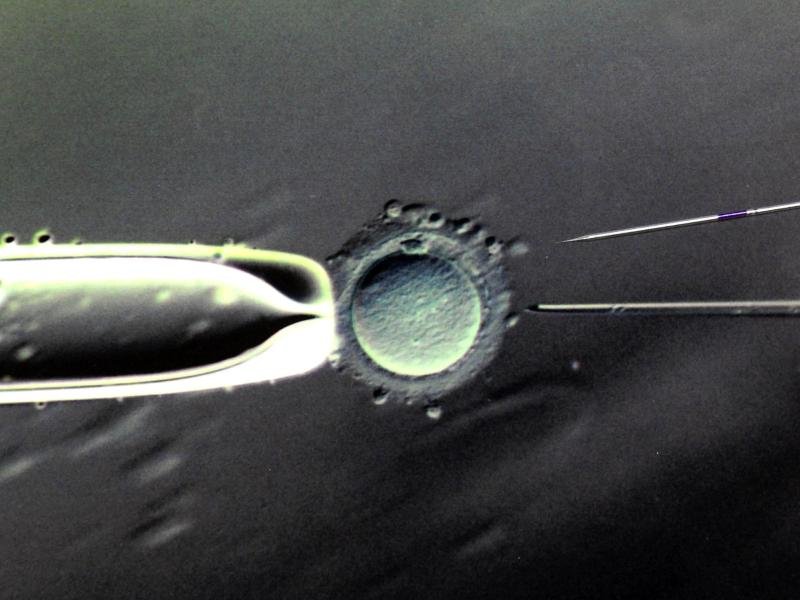Last spring, engineers in Barcelona packed up the components of a sperm injection robot and shipped it to New York via DHL. They then followed him to the New Hope Clinic, where they reassembled a microscope, a mechanized needle, a tiny Petri dish, and a laptop into an insemination device.
The next step was for one of the engineers, who had no experience in fertility medicine, to first position the robotic needle using a Sony PlayStation 5 controller. This then moved independently towards a human egg cell, which was observed by a camera, penetrated and released a single sperm cell. In total, the robot fertilized more than a dozen egg cells in this way. This resulted in healthy embryos.
Recently, two little girls were born from two pregnancies, which the researchers say are the first people to be born after robotic insemination. “I was very calm. At that moment I thought, ‘This is just another experiment,'” says Eduard Alba, the mechanical engineering student who oversaw the sperm insertion device.
Automation of artificial insemination
The start-up Overture Life, which developed the robot, described the device as the first step towards automating in vitro fertilization (IVF). It could make the process cheaper and far more common than it is today.
Currently, IVF labs are multi-million dollar corporations, where trained embryologists make up to $125,000 a year treating sperm and eggs with ultra-thin hollow needles under a microscope.
However, some startups suggest that the whole process could be automated, or at least almost automated. Overture, for example, has filed a patent application for a biochip that describes a miniature IVF lab, complete with hidden reservoirs for growth fluids and tiny channels for sperm to snake through.
“Imagine a box that sperm and eggs go in and an embryo comes out of five days later,” says Santiago Munné, an award-winning geneticist and chief innovation officer at the Spanish company. He is convinced that artificial insemination that can be carried out in a tabletop device can ensure that patients may never have to visit a specialist clinic again. In the US, a single attempt to conceive via IVF can cost $20,000. Instead, a patient’s eggs would be fed directly into an automated fertility system in a gynecologist’s office. “It has to be cheaper, and if every doctor could do it, it would be,” says Munné.
MIT Technology Review identified half a dozen startups with similar goals, including AutoIVF, IVF 2.0, Conceivable Life Sciences, and Fertilis. Some have their roots in university labs specializing in miniaturized lab-on-a-chip technology. So far, Overture has raised the most money, around $37 million. It comes from investors like Khosla Ventures and Susan Wojcicki, the former YouTube CEO.
Goal of the automation: more babies
According to the entrepreneurs, the main goal of IVF automation is quite simple: it is about having many more babies. Around 500,000 children are born through IVF worldwide each year. However, most people who need help conceiving children do not have access to, or are unable to afford, fertility medicine.
However, fully automating artificial insemination will not be easy. In vitro fertilization involves a dozen procedures, and Overture’s robot has only performed one of them, and only partially. “The concept is extraordinary, but this is a small step,” says Gianpiero Palermo, a fertility doctor at Weill Cornell Medical Center. He is credited with developing what is known as intracytoplasmic sperm injection (ICSI) in the 1990s. Palermo notes that Overture’s researchers still rely on manual assistance when it comes to getting a sperm cell into the hypodermic needle. “In my opinion, this is not robotic ICSI yet,” he says.
Other doctors are skeptical that robots can or should replace embryologists any time soon. “You pick up a sperm and insert it into an egg with minimal trauma and as gently as possible,” says Zev Williams, director of Columbia University’s fertility clinic. At the moment, humans are much better than machines,” he says.
His center has also developed an assistive robot for IVF, but with a more limited goal: to dispense tiny droplets of the growth medium in which the embryos are to grow. “It’s not good for the embryos if the droplet size varies,” says Williams. “Creating the same drops over and over again is where the robot can shine.” He calls it a “low-risk” way to introduce automation into the lab.
